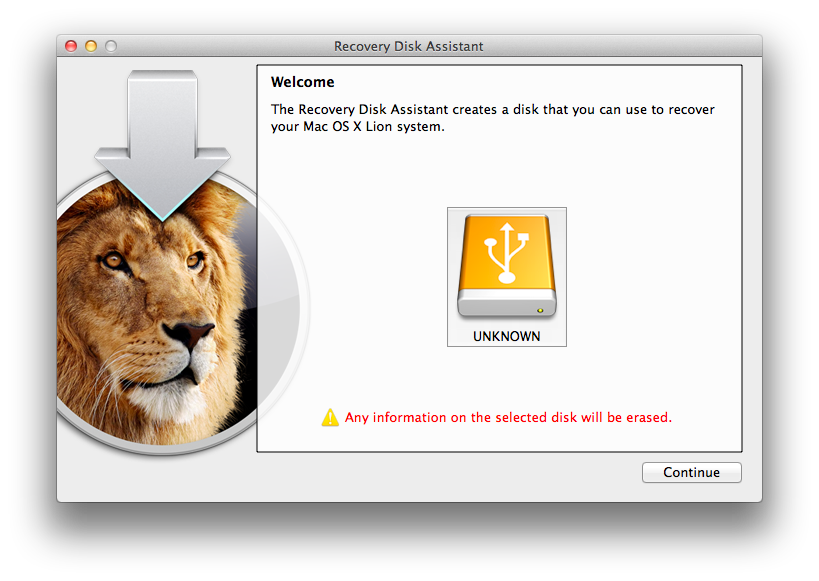
Questions? Comments? Have a fix? Post them below or e-mail us!īe sure to check us out on Twitter and the CNET Mac forums. If you cannot create a recovery disk because your system does not have a Recovery HD partition, then you can download the Lion installer to create an installation drive from it, or wait, since, as we reported earlier, Apple may be gearing up to offer recovery drives to people who cannot make them themselves. Therefore, if you have already created a recovery partition for yourself, either from the Recovery HD partition or better yet from the Lion installer application, then you do not need to use this utility. The tool requires an existing Recovery HD partition on the Mac that is creating it, and works by creating a block-level clone of the partition to your designated drive. It requires OS X 10.7 Lion with a Recovery HD. While this tool is convenient, it does not provide any new recovery options beyond what we have already discussed about creating your own Lion recovery partition. Lion Recovery Disk Assistant will install the Lion Recovery partition to external media so you can create another boot disk. Apple's tool creates a block-level clone of the Recovery HD partition on an external drive. We have reported extensively on this and the options for handling it, which have included mirroring the Lion recovery partition on an external drive, and creating your own Lion installation disk from the Lion installer that you download from the Mac App Store.Īpple has apparently taken people's concerns to heart, and has released a Lion Recovery Disk Assistant tool that you can use to create your own portable recovery disk, either on a USB flash drive or as a separate partition on any USB or FireWire hard drive (more information on the tool, including instructions, can be found here). If you have a difficult time describing what you see, a screen shot, or even a picture, would help greatly.One of the hot topics regarding OS X Lion has been the lack of a physical installation drive that be used in troubleshooting problems and to recover or reinstall the operating system. Let me know what about this does not work for you, such as where it stops, and what you see on the screen. When it is done, your Mac will automatically restart, and take you to the setup for a new user account. (This is an application to create an external disk which can be used to restore Mountain Lion to the computer drive.) The Assistant prompted me to connect an external USB drive. Again, the install will take 30 minutes or so - maybe more than an hour, but usually not that long. My Passport for Mac (1T) is unreadable It worked perfectly until I connected it to my MacBook while I was running the Mountain Lion application, Recovery Disk Assistant. Follow the short steps to select your hard drive (which you just erased), and continue with the install. La versión 1.0 es la más descargada por los usuarios del. El nombre de archivo de instalación más frecuente para este programa es RecoveryDiskAssistant.dmg. No podemos garantizar que la descarga gratituita esté disponible. Quit Disk Utility, then choose Reinstall OS X. You know how to create your own Lion recovery disk, thanks to our guide or your own ingenuity, but Apple just made it easier with their Lion Recovery Disk. Recovery Disk Assistant 1.0 estaba disponible para descargar desde el sitio web del desarrollador cuando lo revisamos.

Takes a few seconds to complete, and your hard drive is erased. Name the hard drive if you like, make sure the format is set for MacOS Extended(journaled), then click the Erase button. Click on the manufacturer's line so it is selected, then click on the Erase tab.

Then underneath would show the partition name, like Macintosh HD, or Mac HD, or something with someone's name (because someone else, such as yourself, actually named it!). It will probably be the only one with a manufacuturer's part number - like WD35J0600- 600GB. On the first screen, where you can choose from a list with one being Disk Utility, Open Disk Utility, then choose your hard drive. To access OS X Recovery, reboot the computer while holding the Option key. When the OS X Recovery Disk Assistant completes, the new partition will not be visible in the Finder or Disk Utility. If you just want to erase the hard drive completely, and install OS X to an erased hard drive, then why not just do that? Insert an external drive, launch the OS X Recovery Disk Assistant, select the drive where you would like to install, and follow the on-screen instructions. I would suggest that you simply start over from the beginning of the install. However, I don't quite understand what you mean.Īre you saying that you have booted to the Lion installer, and you can't actually start the install? If you have completed the Lion install (which would take 30 minutes or so), then you should simply ignore (for now) the Recovery HD. The Recovery HD is installed as part of the Lion install.


 0 kommentar(er)
0 kommentar(er)
